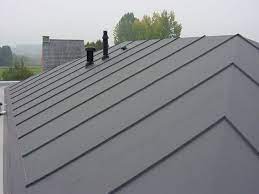Introduction
Before investing in your new roofing system, you must know what you are purchasing and the benefits. Here is some basic information on roofing PVC membranes to assist you in making an informed purchasing decision.
The roofs of commercial buildings are usually flat. EPDM, TPO, and PVC are the most commonly used roofing membranes. It is believed that PVC flat roofing membranes will last at least two decades out of these three materials. Among the many benefits they offer, this is only one. You can learn many things about roofing PVC membranes in this article.
Roofing PVC membrane
It is important to note that PVC comes as a membrane, similar to other flat roofing materials. Adhesives or nails are used to attach this membrane to the roof deck. As a result of the inclusion of polymers in the membrane, it is waterproof to punctures and tears.
These qualities make it an deal alternative for specific commercial structures due to its chemical resistance and low maintenance requirements. Heat welding is often used to seal the seams of PVC roofing. Since flat roof seams are particularly vulnerable, heat welding helps seal and protect them. With a decent PVC roof, you can enjoy the best of both worlds: a lightweight roof that remains durable for many years.
The biggest problem associated with employing PVC roofing as a flat roof covering is its inability to interact with asphalt materials. Depending on the type of flat roof, hot asphalt may be applied to the membrane.
It is not possible to combine asphalt roofing with PVC roofing. Keeping them apart is therefore necessary. PVC roofing is available in a range of thicknesses. There is no reason to put a thin roof on a flat roof, especially since this is a flat roof.
Installation methods of roofing PVC membrane
There are three basic methods available to install a PVC membrane roof. A PVC roof is usually constructed using fully adhered materials, mechanically fastened materials, or induction welded materials.
PVC roofing that adheres to itself
With a robust commercial adhesive, the PVC membrane roofing material is glued directly to the existing substrate. In most cases, this method is used when a structure cannot easily support fasteners or when the owner wishes to minimize penetrations into the roof structure.
PVC roofing attached mechanically
Heavy-duty screws and plates are used to secure the PVC membrane roofing materials. An attached PVC roof is preferred in areas prone to severe weather events such as hurricanes and tornadoes.
PVC roofing that has been induction welded
The process involves deploying heating equipment above the metal plate locations on the PVC membrane roofing. An induction welding tool uses electric pulses that cause the materials to adhere to the metal plate to be transmitted. Compared to other roofing systems, PVC systems welded with induction require fewer fasteners and are typically less labor-intensive.
Advantages of roofing PVC membrane
Exceptionally long service life
Because of its strength and durability, PVC roofing should last long. If properly installed and maintained, it should last approximately 20 years. Although this material costs more initially, it will save you thousands of dollars in repairs, maintenance, and even replacement in the long run.
Resilience to fire
The PVC roofs are also wind and fire-resistant. This roof membrane is resistant to harmful oxidation reactions, making it difficult to ignite. Installing PVC roofing on your home or business adds a layer of protection.
Durable and water-resistant
In addition, they can tolerate ponding, the condition water pools on the roof, and conditions with high and low alkaline levels. Mold, bacteria, and roots of plants are also resistant to them.
Friendly to the environment
In addition to being largely recyclable, PVC roofing’s membrane has a high solar reflectivity. As a result, less energy is consumed, and energy bills are lower. The heat and cooling you need can be met with a PVC roof, just like metal roofing.
Inherent wind resistance
The welded seams on PVC roofs provide superior wind resistance. There is evidence that PVC roofs can often withstand hurricanes of Category 3. In areas prone to intense winds and hurricanes, PVC roofs make a good choice.
Inhibition of chemical reactions
Chemicals are commonly found in warehouses, manufacturing facilities, and other commercial buildings. This kind of damage can also be prevented by highly resistant PVC roofing.
In contrast, harsh chemicals and toxins can cause considerable damage to other materials, including asphalt and single-ply roofing membranes. Therefore, PVC roofing would be a wise investment if your building falls into this category.
How can we extend the life of roofing PVC membrane?
It is possible to extend the life of PVC roofing by over 20 years since it is highly durable and robust. Having a durable roof is one of its main advantages. This way, you may save considerable money on costly repairs and maintenance. Your business will benefit from more investment money. Maintaining your PVC roof can extend its lifespan. Here are some examples:
You must maintain proper drainage to prolong your PVC roof’s life. As a result, ponding water must be prevented, a common problem with flat roofs.
In the absence of proper drainage, ponding water, also called standing water, can lead to water seeping through your roof. It will result in severe water damage and expensive repairs. Ponding water often results in damage that is not apparent until mold and rot start to form.
In addition to inspecting flashing and seams following a rainstorm, keeping your PVC roofing membrane in good condition is essential.
Before leakage occurs, inspect the roofing membrane for any worn or damaged areas so that the lifespan of the membrane is not shortened or further damage is not caused.
FAQs
What is the difference between PVC and TPO roofing?
Polyethylene or ethylene thermoplastic is bonded to ethylene propylene rubber to form TPO roofing membranes. After polymerizing vinyl chloride monomers, plasticizers are added to PVC roofing membranes to make them more flexible.
What is the R-value of a PVC roofing membrane?
Before installing the PVC roofing membrane, some insulation board is typically put in. Foam board insulation, such as ISO or EPS, is commonly used. For every inch of insulation thickness, these insulation boards have an R-value of 4 to 6 R. The purpose of insulation is to reduce heat loss and thus save energy.
Apart from this, if you are interested to know more about METAL ROOFING COST VS SHINGLE then visit our HOME IMPROVEMENT category.











